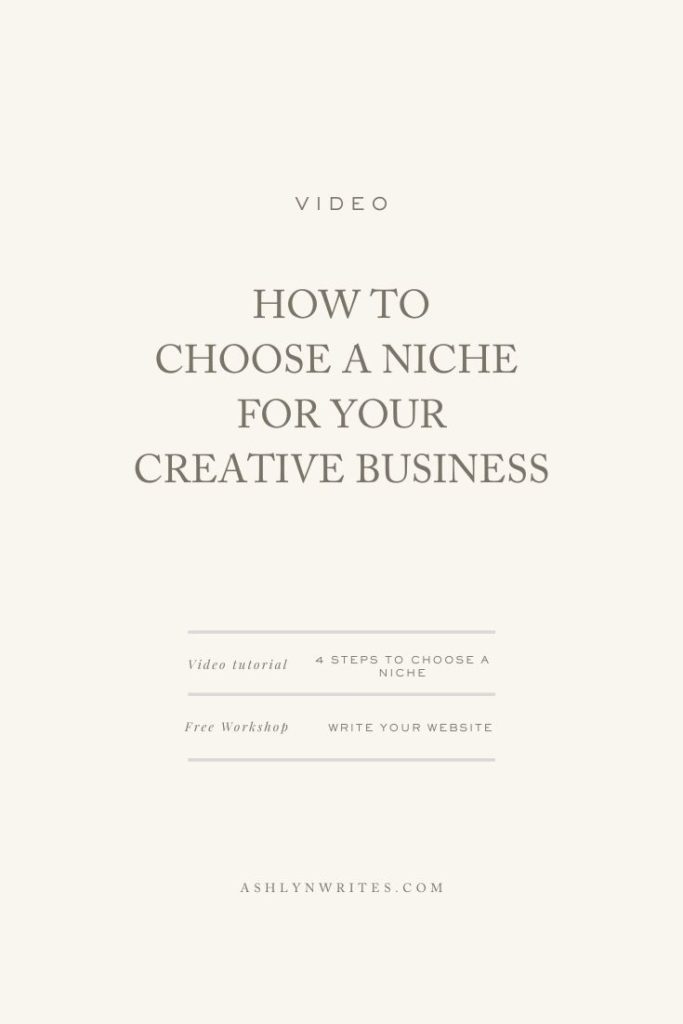How do you nail down a niche for your creative business when you feel like it’s ALL been done, and how do you overcome the fear that not enough people will need your niche to keep you in business?
For the record: both are TOTALLY possible.
And, for the first time here on the Interweb, I’m teaching you how to choose a niche that marries your passion and future profits.

As I was looking at a few of the recently launched websites from alum members of my Copywriting for Creatives™ program, it hit me: I’ve seen some killer case studies on narrow niches.
When people ask me how I grew my business, this always comes up—if you’ve ever heard me talk about building a successful and sustainable brand, you’ve heard me talk about niching. But never before have I actually taught how to find your niche. Something that, when I created my business, made all the difference in my success.
But how niched is TOO niched? And what do you do when you feel like you have the best idea or perfect dream, but it’s already being done.
What about when you feel like it’s too competitive, too late, or an uphill battle to narrowing down your niche and standing out in the crowd all at the same time?
Time and again, with every client and student I serve with copywriting and brand strategy, I see people killing it in niches I didn’t even know were a THING, and they have a super successful businesses.
I’ve also learned from my own experience building a seven-figure business in a niche that I honestly thought was too narrow.
I’ll be super honest with you—when I first started out on this adventure, I didn’t believe in niching. I thought it sounded like a terrible idea. But once I finally started narrowing the scope of my ideal client and audience, the more money we made. (And, no, I’m not afraid to talk about making money as a metric for success. The numbers don’t lie.)
There’s no scientific formula for choosing a niche, so I’m just going to share the method that I used to close in on mine. Niching your business isn’t difficult, per se, but it is pretty intimidating.
Recently I asked about niching on my Instagram stories, and one reply I got from Jaime was on point: it feels like such a commitment. And if you’re anything like me, when people are offering to pay you to be a jack of all trades, would you want to niche down and say “no” to a task you know you could do? You can bet I’ve got some thoughts on that. 😉
Here are the 4 steps you need to know to choose a niche for your creative business—even if you’re passionate about more than one thing.
Step 1: Look at your interests
For many of us creative types, we HAVE to find at least some fulfillment in what we do.
There’s a quote attributed to Aristotle “Where the needs of the world and your talents cross, there lies your vocation”—and that’s similar to something productivity expert Bob Pozen once said: “You need to not only know what you’re best at, but what skills your organization, your industry, and the world are looking for.”
Brilliant! Both of ‘em.
It’s real noisy and competitive out there … when people land on your website, they need to quickly know if you’re a good match for them, whether you’re to be trusted to help them, and how to take action, or politely move along.
(Yep. You read that right. I said, we want some people to decide you’re not for them.)
So—no need to get fancy with it—whip out a pen and paper and write down all your hobbies and interests.
Ask yourself:
- What are your biggest passions and interests?
- What would your dream business be?
- What are you interested in learning more about or what could be fun?
And, here’s an important one: What experience (work or growing up) do you have that you could use to serve others?
We’re at a place in the information age and online business world where you can quite likely figure out how to build a business with something you’re passionate about. Which is a pretty cool blessing if you think about it.
Here’s another exercise: Before I left the corporate world after I got out of eating disorder recovery and was trying to figure out what I even wanted to do to with my life, I asked a few close friends and family members to email me and affirm the talents or gifts they saw in me.
Maybe that sounds super cheesy, but it was hugely helpful in identifying my strengths—and having people who were important to me affirm them? Man, did that make me brave! (There’s nothing like a little pep talk from people you love and respect, amiright?)
Another thing to journal through … what is something that your friends and family ask you about all the time?
Friends were always asking me to review their resume, or help edit an email to their boss, or give them pointers on social media marketing and public relations.
I think so many times people see what I’m doing now and think it just happened: that my experience as a calligrapher helped me understand the creative market, and I KNEW I wanted to start a copywriting business, and that’s DEF not exactly how it happened.
I had to go through this process of identifying my path and finding my niche, too, and my first few months, I was writing everything from blog content marketing pieces for corporations in Atlanta, editorial content for local magazines, editing resumes, doing calligraphy chalkboards for weddings—just trying to figure out where the Ashlyn-shaped hole in the market was.
I knew I loved writing and marketing—that’s what people always asked me about.
You’re probably going to get a lot of ideas out of these exercises, which brings me to step no. 2.
Related: How to Become a Copywriting and own your niche
Step 2: Look up the profit potential—and validate your idea.
To me, this is how you choose between your best options when you’re passionate about more than one thing, like I was.
How do you know if there’s demand for your skills? I always tell my CfC students to find the YOU-size gap in the market and go fill it, because you can be passionate about art or hand-dyed silk ribbon or pet photography all day long, but if no one’s going to pay for it, you’re D.O.A., just like the Friends song says.
Most of this research can be done online, but I’d be wrong to lead you to believe you can find ALL the answers. It’s never possible to know for SURE if this will be something people pay for, but the research sure does help.
And while we’re truth-talkin’, NO, the good ideas are not all already taken. We just need to dig past the surface!
Look up the keywords related to your list of passions & ideas—see what’s there and what competition is waiting for you. If you Google what you’re interested in and there are a TON of ads that come up for it, and a ton of competition, I’d get more narrow.
Look in Google Trends.
Are there books on Amazon or magazines about this? That can be a good indicator, too.
Niching always reminds me of magazines—I was in journalism school when the 2009 economic downturn hit, and I remember interning at Time Inc.’s Southern Living when Southern Accents folded—so many magazines were folding, too—and then, something interesting happened … there started to be a new crop of hyper niche, weirdly specific magazines. And what’s more? They were succeeding!
Hard copy publications can also be a good indicator of what could be profitable.
Now if you’re sitting there thinking: “what if I don’t see a specific reflection of someone working in the niche I want to work with?” Welp, friend—this was my story. I was a moonlight wedding calligrapher, but I was seeing a ton of questions inside the Rising Tide Society Facebook group that I knew I could answer.
I was reading, reading, reading all.the.posts inside these FB groups and forums. I also went to meet-ups and listened to the conversations these creative entrepreneur peers of mine were having, looking at the problems I was seeing, and they all had to do with sales and communication, but no one was saying the word “copywriting.”
No one.
It was like they didn’t know the word existed. (And I was sitting there, hands clasped below my chin, bopping up and down in my chair going somebody’s going to say it! Right? Nope. Crickets.)
I’d ask in Facebook groups if I could help anyone with copywriting or answer whatever questions they had—I knew I could help with their challenges—and literally people would respond saying they already knew a great lawyer.
Whoa, dudes, wrong copywriting.
And here’s where I learned the lesson—sometimes people are SAYING and asking for something, but not in the words that you’d use to sell to them. Sometimes there’s a niche where it looks like there’s no demand and or proven track record.
And sure … ringing in my ears, I hear this: “The reality is in 99.99% of cases if nobody else is doing it, it’s because there isn’t money to be made.”
There’s a grain of truth in that.
But I DID find success in a niche that no one was serving back when I started my business. It was hard, I had to do a ton of education and building my value proposition, but it is possible, and there was money to be made.
Related: How to Organize Your Market Research
Step 3: Test the waters.
Sometimes, you’ve just gotta put stuff out there and see if it flies. Especially if your current audience isn’t in the niche you want to serve, this is really important.
If it’s a service, you can beta test it with a small group of people—but I have a personal rule, I either do work at full price or for free … I don’t discount my services.
Someone recently asked me on Instagram how do you get work that fits your new niche without a portfolio of client work that shows your value?
Well, there are people on both sides of the aisle with this, but what I did was test my new process for what my work was worth at the time. I think you still charge. When you steeply discount your services, I think it undercuts the value of the people that DO have to charge because this is their job. (And, it undercuts your future value if that client were to ever return to you for more work.)
Other ideas for testing? Free content. That’s how I tested my ideas. I pitched free content, I blogged constantly, I pinned constantly, and eventually, my content convinced people they needed what I offered. I followed the analytics, and the stuff that got the most traction is what I built offers around.
After you’ve seen what your passions are and where they overlap with that market gap, there’s one last important fit.
Step 4: Define how you’re different.
Because if you’re not doing anything differently, why would anyone pay attention? You’ve got to be able to explain how you’re different from anyone else doing what you do and how your methods are unlike any other way other people are solving the problem.
You HAVE to find your unique angle—your onlyness factor—within your niche.
An Instagram follower asked me recently how niche is too niche, and this is my answer—I tell my students inside CfC that you need to be able to state your differentiating factor and with 99% certainty say you’re the only one who can fulfill that statement. I know that’s bold, I know that’s scary, but I firmly believe it, and it’s why we spend SO much time with our students working to figure that out!
Again, to use my business as an example, we focus on just a few specific things, and we do them really well. Copywriting is a niche inside marketing, to an extent. I was playing around with so many marketing facets, but decided my favorite part of agency had always been brand messaging and drafting website and email copy. I’m JUST interested in conversion copy—brand messaging, website copy, email copy, and launch copy needs (ads, funnels, sales pages, landing pages). There are a lot of things I don’t write: no content marketing pieces, no script writing, and I never touch social media copy.
After you pick your horizontal niche (your market or field), it’s time to choose a vertical niche—serving a specific audience and their set of needs. This is where I see a lot of creatives resist. Now you don’t have to do this to be successful. But when people ask how I grew fast, this is my answer: I became the go-to girl for a specific group of people.
I talk more about horizontal and vertical niching inside my video about how to start a writing business, if you want a bit more info.
Related: How to Kick Off your Brand Strategy Process
Can you take on other work that’s outside of your niche? Absolutely. I help non-niche brands out on pro bono projects, I think it just comes down to being careful what you put in your portfolio.
I PROMISE it’s possible to scale within a tight niche.
Go read that article you’ve probably already read before about 1,000 True Fans. If you can just find 1,000 people who are interested in what you do, you can build a business. There are 3.2 billion people on the internet—I bet there are 1,000 out there who are interested in what you do.
Then what?
Now it’s time to BRING IT!
Put a stake in the ground and say exactly what you do.
I know this is scary, it was for me too.
Skipped to the bottom? Didn’t have time to read this in its entirety? Make sure to PIN it to Pinterest so you can come back to it another time!

Need help with your messaging? Make sure to grab my FREE Brand Voice Guide below!
Reading Time: 9 Minutes Reading time: 10 min. How do you nail down a niche for your creative business when you feel like it’s ALL been done, and how do you overcome the fear that not enough people will need your niche to keep you in business? For the record: both are TOTALLY possible. And, for the first time […]




comments +